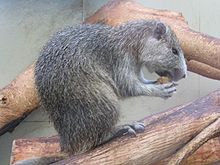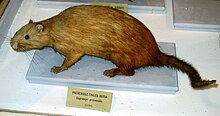Hutia
| Hutia Temporal range:
| |
|---|---|

| |
| Desmarest's hutia (Capromys pilorides) | |
| Scientific classification | |
| Domain: | Eukaryota |
| Kingdom: | Animalia |
| Phylum: | Chordata |
| Class: | Mammalia |
| Order: | Rodentia |
| Family: | Echimyidae |
| Subfamily: | Capromyinae Smith, 1842 |
| Type genus | |
| Capromys Desmarest, 1822
| |
| Genera | |
|
Tribe Capromyini
Tribe Plagiodontini
†Tribe Hexolobodontini
†Tribe Isolobodontini | |
Hutias (known in Spanish as jutía[1]) are moderately large cavy-like rodents of the subfamily Capromyinae that inhabit the Caribbean islands. Most species are restricted to Cuba, but species are known from all of the Greater Antilles, as well as The Bahamas and (formerly) Little Swan Island off of Honduras.
Twenty species of hutia have been identified, but at least half are
The extinct
Description
Most species have a head-and-body length that ranges from 21 to 46 cm (8.3 to 18.1 in) and weigh less than 2 kg (4.4 lb), but
They are hunted for food in Cuba, where they are often cooked in a large pot with wild nuts and honey. At the Guantanamo Bay Naval Base however, there is an over population due to an abundant food source and the lack of natural predators. Desmarest's hutias are referred to by those stationed at the Guantanamo Bay Naval Base as banana rats.[4] Banana rats are not named for their dietary preference, but because their feces look like small versions of the fruit. They are known to come out at night.
Phylogeny
Molecular studies of phylogeny indicate that hutias nest within the Neotropical spiny rats (Echimyidae).[5] Indeed, the hutia subfamily, Capromyinae, is the sister group to Owl's spiny rat Carterodon.[6] In turn, this clade shares phylogenetic affinities with a subfamily of spiny rats, the Euryzygomatomyinae.[6]
Within Capromyidae, the deepest split involves Plagiodontia with respect to other genera, followed by the divergence of Geocapromys. The latter genus is the sister group to a clade in which Capromys branches off before the Mesocapromys and Mysateles split.
| Genus-level cladogram of the Capromyidae with their relationship to Carterodon and Euryzygomatomyinae. | |||||||||||||||||||||||
| |||||||||||||||||||||||
| The cladogram has been reconstructed from mitochondrial and nuclear DNA characters.[7][8][9][5][10][6] |
Hutias colonized the islands of the Caribbean as far as the
Systematics

The systematics of the 10 extant and 11
Taxa known to be extinct are marked with a dagger (†).- Subfamily Capromyinae
- Tribe Capromyini
- Capromys
- extinct)
- Desmarest's hutia (Capromys pilorides)
- Geocapromys
- Jamaican hutia(Geocapromys brownii)
- Bahamian hutia (Geocapromys ingrahami)
- †Cayman hutia (Geocapromys caymanensis)
- †Cuban coney (Geocapromys columbianus)
- †Little Swan Island hutia (Geocapromys thoracatus)
- Mesocapromys
- Cabrera's hutia (Mesocapromys angelcabrerai)
- Eared hutia (Mesocapromys auritus)
- Black-tailed hutia (Mesocapromys melanurus)
- Dwarf hutia (Mesocapromys nana) (possibly extinct)
- San Felipe hutia (Mesocapromys sanfelipensis) (possibly extinct)
- Mysateles
- Prehensile-tailed hutia (Mysateles prehensilis)
- Capromys
- Tribe †Hexolobodontini
- †Hexolobodon
- †Imposter hutia (Hexolobodon phenax)
- †
- Tribe Isolobodontini
- †Isolobodon
- †Montane hutia (Isolobodon montanus)
- †Puerto Rican hutia (Isolobodon portoricensis)
- †Isolobodon
- Tribe Plagiodontini
- Plagiodontia
- Hispaniolan hutia (Plagiodontia aedium)
- †Samaná hutia (Plagiodontia ipnaeum)
- †Small Haitian hutia (Plagiodonta spelaeum)
- †Hyperplagiodontia
- †Wide-toothed hutia(Hyperplagiodontia araeum)
- †
- †Rhizoplagiodontia
- †Lemke's hutia (Rhizoplagiodontia lemkei)
- Plagiodontia
- Tribe Capromyini
References
- ^ "Cuba's government mocked by stampede of ostrich memes". BBC News. 23 April 2019.
- PMID 25115033.
- ISBN 0-8018-5789-9.
- ^ Larson, Vaughn (23 September 2008). "Sailor Volunteers to Help Base Environment". Joint Task Force Guantanamo Public Affairs. Retrieved 24 September 2011.
- ^ PMID 25115033.
- ^ PMID 28025278.
- PMID 15683932.
- PMID 22327013.
- S2CID 83639441.
- ^ Upham, Nathan S.; Patterson, Bruce D. (2015). "Evolution of Caviomorph rodents: a complete phylogeny and timetree for living genera". In Vassallo, Aldo Ivan; Antenucci, Daniel (eds.). Biology of caviomorph rodents: diversity and evolution. Buenos Aires: SAREM Series A, Mammalogical Research — Sociedad Argentina para el Estudio de los Mamíferos. pp. 63–120.
- .
- S2CID 198149958.
- S2CID 140178414.
- OCLC 62265494.
- ISBN 978-84-941892-3-4.
- , retrieved 2021-09-27
External links
- The last survivors conservation project (archived 3 June 2010)
